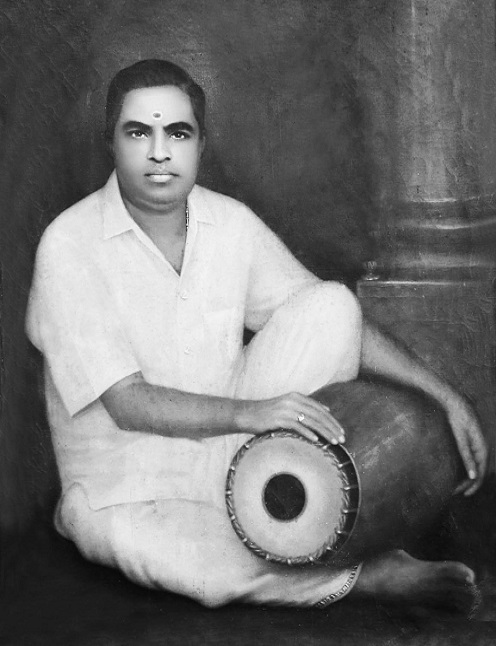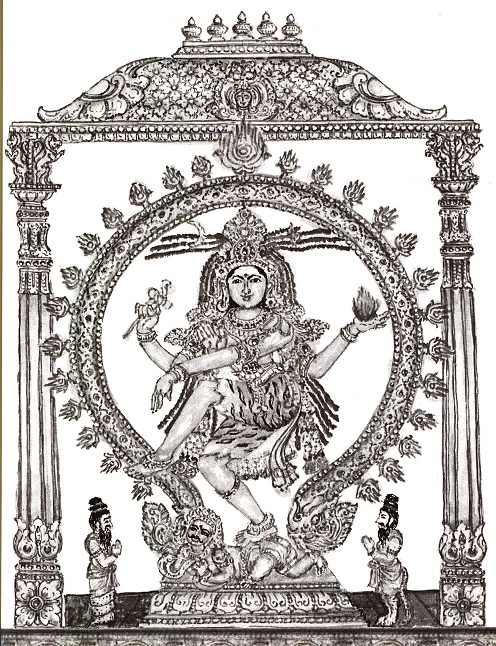How Sikkil C. Gurucharan became a vocalist is itself curious—even to him! Born in Chennai on 21 June 1982 to V. Chandrasekaran and Mythili (daughter of Sikkil Kunjumani, the elder of the Sikkil Sisters flautist-duo), he recollects his grandmothers testing the blowing ability of prospective flute students by asking them to blow into a pen cap. Gurucharan’s musical aptitude was discovered as a child when he whistled a film song correctly whilst walking down the stairs at his home. He then sang the same song, perfectly in sruti, which made his grandmothers decide that the boy should be trained in vocal music. Now, some 35 years later, he remains the sole vocalist in his family, almost everyone else having learned the flute. “My mother had an arangetram in vocal,” clarifies Gurucharan. She, however, switched to the family instrument soon after and was on the flute faculty of the Tamil Nadu Government Music College for a few years. Gurucharan adds that his elder sister Lavanya, who too learned the flute, is most astute musically but elected to pursue academics.
Sikkil Gurucharan, Kapila Vatsyayan and Mavelikkara Krishnankutty Nair
- Issue 448
- Published By Sruti
-
₹120.00
Kapila Vatsyayan was a grand matriarch of Indian culture, an administrator, institution builder, a leading scholar of Indian classical dance, art, architecture, and art history. She was a pioneer in cultural research in India. She brought a holistic, multicultural approach to understanding Indian culture, combining theoretical knowledge with practice, which generated interest in research work. She played a major role in positioning the dance forms, art and culture of India on the cultural world map. Kapila was born in an illustrious family to Satyawati and Ram Lal Malik on 25 December 1928 in Delhi. She studied at Shantiniketan, learnt Kathak from Achhan Maharaj, Manipuri from Amobi Singh, and Bharatanatyam from Pandanallur Meenakshisundaram Pillai. She got the opportunity to perform Kathak at the first Dance Festival organised at Feroze Shah Kotla Grounds in 1945.
Born on 1 October 1921, Mavelikkara Krishnankutty Nair was born to Parukutty Amma and Mavelikkara Narayana Pillai, a theatre artist. As a child, he spent most of his time in a Krishna temple in the neighbourhood and exhibited a taste for percussion. Nair participated in the nama sankeertana programmes in the temple and even received a gift at the tender age of five for playing khanjira in a programme. Krishnankutty had two sisters—Bhagavathy and Kaveri. The family had close interaction with the Mavelikkara palace as Nair’s maternal grandfather was employed there. As a child, Nair was attracted by the sound of the mridangam emanating from the classes for the boys at the palace, and he watched it from a distance for long hours. The mridangam master Alappuzha Venkappan Pillai, who observed the keen interest of the young lad, included him along with the palace children and thus started the regular lessons for Nair, which laid the foundation for a highly successful career in mridangam spanning six decades. Subsequently, Nair had advanced tutelage under Vechoor Krishna Iyer.
Veil of Colours The fifth of the pancha sabhas is Tirukuttralam. The hall here is the Chitra sabha, also known as Oviya sabhai or Vannambalam. The Ananda tandava Nataraja in the Chitra sabha is in the form of a mural. Allegorically, mind is the chitra sabha; the Lord should be made to remain here in a colourful and resplendent form. As the flower in a mural will always be in full bloom with no wear or tear, the jeeva should house the pristine beauty of Godliness forever. The special dance of the Chitra sabha of Kuttralam is the ‘Tripura tandava’ or the ‘dance of veiling’. The term ‘tripura’ calls for further study. Lord Siva is hailed as Tripurari, Tripurasundarar, Tripura samhari, Tripurantaka and Tripureswara. What is the legend all about? Three asura brothers named Kamalaksha, Tarakaksha and Vidhyunmali performed great tapas and acquired extensive boons. They had also got a promise that they could be destroyed only by Lord Siva, that too only in a single attempt and by a single arrow when their three metallic castles would align in a single line. The Lord destroyed them not by an arrow but with a single smile, and the castles were burnt down.
CONTENTS Vol.
29 Issue 1 January 2022
6 News & notes
12 Snapshorts
14 Birthday calendar
16 Sikkil C. Gurucharan
28 Kapila Vatsyayan
34 Centenary tribute v
Mavelikkara Krishnankutty Nair
40 Heritage sthalams v Chitra
sabha in Tirukuttralam
42 Tribute v Sivasakthi Sivanesan
44 New initiative v Manam—an
inspiration
47 Tukkadas v Interesting tidbits on Carnatic
ragas
49 Bookshelf
50 From the Editor
Front
Cover: Sikkil Gurucharan
(photo by Hemamalini S.)
Kapila Vatsyayan
Mavelikkara
Krishnankutty Nair
No.
448
COVER STORY
Sikkil C. Gurucharan - EXCELLENT
VOCALIST IN A FAMILY OF FLAUTISTS LAKSHMI
ANAND
How
Sikkil C. Gurucharan became a vocalist is itself curious—even to him! Born in
Chennai on 21 June 1982 to V. Chandrasekaran and Mythili (daughter
of Sikkil Kunjumani, the elder of the Sikkil Sisters flautist-duo), he
recollects his grandmothers testing the blowing ability of prospective flute
students by asking them to blow into a pen cap. Gurucharan’s musical aptitude
was discovered as a child when he whistled a film song correctly whilst walking
down the stairs at his home. He then sang the same song, perfectly in sruti,
which made his grandmothers decide that the boy should be trained in vocal
music. Now, some 35 years later, he remains the sole vocalist in his family,
almost everyone else having learned the flute. “My mother had an arangetram in
vocal,” clarifies Gurucharan. She, however, switched to the family instrument
soon after and was on the flute faculty of the Tamil Nadu Government Music
College for a few years. Gurucharan adds that his elder sister Lavanya, who too
learned the flute, is most astute musically but elected to pursue academics.
COVER STORY
TRIBUTE
KAPILA
VATSYAYAN - ERUDITE SCHOLAR WITH AN INTEGRAL VISION FOR THE ARTS S. JANAKI
Kapila Vatsyayan was a grand matriarch of
Indian culture, an administrator, institution builder, a leading scholar of
Indian classical dance, art, architecture, and art history. She was a pioneer
in cultural research in India. She brought a holistic, multicultural approach
to understanding Indian culture, combining theoretical knowledge with practice,
which generated interest in research work. She played a major role in positioning
the dance forms, art and culture of India
on the cultural world map.
Kapila was born in an illustrious family to Satyawati and Ram Lal Malik
on 25 December 1928 in Delhi. She studied at Shantiniketan, learnt Kathak from
Achhan Maharaj, Manipuri from Amobi Singh, and Bharatanatyam from Pandanallur
Meenakshisundaram Pillai. She got the opportunity to perform Kathak at the
first Dance Festival organised at Feroze Shah Kotla Grounds in 1945.
CENTENARY
TRIBUTE
Mavelikkara Krishnankutty Nair (1921-1988)
His MRIDANGAM SANG C. RAMAKRISHNAN
Born on 1 October 1921, Mavelikkara
Krishnankutty Nair was born to Parukutty Amma and Mavelikkara Narayana Pillai,
a theatre artist. As a child, he spent most of his time in a Krishna temple in
the neighbourhood and exhibited a taste for percussion. Nair participated in
the nama sankeertana programmes in the temple and even received a gift at the
tender age of five for playing khanjira in a programme. Krishnankutty had two
sisters—Bhagavathy and Kaveri. The family had close interaction with the
Mavelikkara palace as Nair’s maternal grandfather was employed there. As a
child, Nair was attracted by the sound of the mridangam emanating from the
classes for the boys at the palace, and he watched it from a distance for long
hours. The mridangam master Alappuzha Venkappan Pillai, who observed the keen
interest of the young lad, included him along with the palace children and thus
started the regular lessons for Nair, which laid the foundation for a highly
successful career in mridangam spanning six decades. Subsequently, Nair had
advanced tutelage under Vechoor Krishna Iyer.
HERITAGE
STHALAMS
CHITRA
SABHA IN TIRUKUTTRALAM SUDHA SESHAYYAN
Veil of Colours
The fifth of the pancha sabhas is
Tirukuttralam. The hall here is the Chitra sabha, also known as Oviya sabhai or
Vannambalam.
The Ananda tandava Nataraja in the Chitra
sabha is in the form of a mural. Allegorically, mind is the chitra sabha; the
Lord should be made to remain here in a colourful and resplendent form. As the
flower in a mural will always be in full bloom with no wear or tear, the jeeva
should house the pristine beauty of Godliness forever.
The special dance of the Chitra sabha of
Kuttralam is the ‘Tripura tandava’ or the ‘dance of veiling’.
The term ‘tripura’ calls for further
study. Lord Siva is hailed as Tripurari, Tripurasundarar, Tripura samhari,
Tripurantaka and Tripureswara. What is the legend all about? Three asura
brothers named Kamalaksha, Tarakaksha and Vidhyunmali performed great tapas
and acquired extensive boons. They had also got a promise that they could be
destroyed only by Lord Siva, that too only in a single attempt and by a single
arrow when their three metallic castles would align in a single line. The Lord
destroyed them not by an arrow but with a single smile, and the castles were
burnt down.






